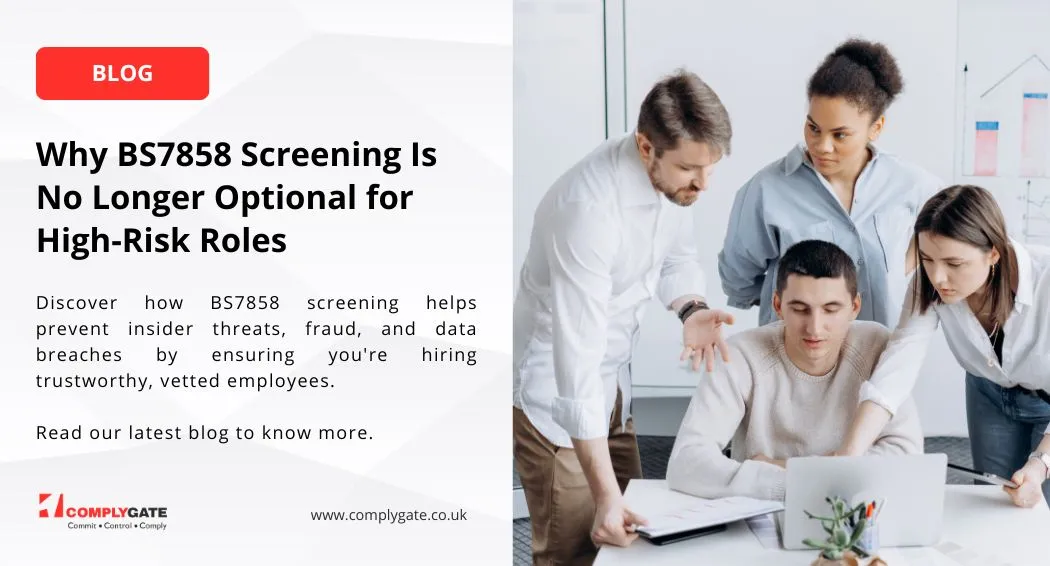Employment Screening: Practices, Gaps and Guidance ©
Employment Screening: Practices, Gaps and Guidance ©
Professor Rowley
Complygate June 2021
Introduction to Practices, Gaps and Guidance to Employment Screening
Following on from my earlier piece on a very fashionable area of employee resourcing – managing agile high performance employees - it is worthwhile to think about the stages before this is needed – what methods might be used in recruiting and selecting people in the first place. Resourcing’s ‘classic trio’ of application form, references and interview remain commonplace, albeit with other formats and procedures with the use of technology and also in the context of the Covid-19 situation. However, many other – often supportive - methods also exist, including a battery of different types of tests, such as practical and psychometric. There is also the use of what is called ‘employment screening’, sometimes labelled ‘background checks’, used to both filter out candidates and confirm assertions and assumptions concerning those of interest and appointed. It is this later practice that is the focus of this paper.
Some Selected Literature on Employment Screening
There is some literature and research in this topic. I note just a succinct selection. From an American perspective, Engleman and Kleiner (1998) point out the liability of employers to the actions of their staff – and even if not job-related. They note, therefore, new approaches and methods for what they call effective pre-employment screening covering a broad spectrum of personal information about the applicant and also that the outsourcing of referencing and background checks is more commonplace. They go on argue that to employ effective screening practices, companies must know three things: 1) What information to gain, 2) How to gain information, 3) What to do with the information once it is received. Wang and Kleiner (2000) list ‘7 Deadly’ hiring mistakes and discuss the concept of ‘negligent hiring’ through poor checks. They note the associated ethics and need to check the legality of procedures. Choi and Kleiner (2002) look at new resourcing techniques and the rise of the use of technology in the screening of employees. However, they conclude that the ‘people element’ remains critical and that technology is only a tool in this. Wang and Kleiner (2004) discuss pre-employment screening and what to look for in resumes/curriculum vitae. Interestingly, from an ethical standpoint they also note the need for post-employment screening to help keep employers aware of changing attitudes.
There is also literature that is more from a practitioner perspective. For example, the HR communities CIPD, with its People Management (Whyman 2019). Furthermore, the CIPD (2020) notes that as traditional recruitment practices continue to evolve, partly driven by technology, organisations need to ensure they follow pre-employment checking procedures that are both legal and ethical. They provide a useful comprehensive guide, which highlights the key checks for organisations to carry out during their recruitment process and which includes case studies to outline the considerations that need to be made when making pre-employment checks.
Similarly, for Personnel Today, Smith (2017) notes that while a vital part of the recruitment process, employee screening is also incredibly complex and throws up numerous challenges for HR and hiring managers who are frequently unsure about issues and even how to keep up with changing compliance regulations to stay on the right side of the law across the screening process. Smith (2017) lists eight areas that organisations should consider and the pitfalls to avoid.
Criminal record checks
It is crucial that checks are proportionate and relevant to the role in question and comply with the relevant acts.
Social media screening
Capturing activity on the internet that could be potentially incriminating, such as anti-social, illegal or violent behaviour carries legal risks if employers get it wrong. For example, employers need to be careful about making employment decisions based in any way on a protected characteristic, such as race, religion or sexual orientation, revealed through social media. If it is successfully argued that discrimination has taken place during the recruitment process, the applicant can be awarded compensation without ever having been employed by the business. Whyman (2019) warns that employers should take care when inspecting social media profiles and it is advisable to only do so when there is a legitimate reason relevant to the job or position, such as where the employee will be a spokesperson or have significant public exposure. Additionally, employers should take reasonable steps should be taken to ensure the accuracy of any personal data found online.
Credit checks
These are used in the financial sector in particular. They should be proportionate to the job role, eg. financial director role, but not in roles that contain no financial responsibilities. Indeed, the Information Commissioner’s Office recommends that credit checks are only carried out when there is no less intrusive alternative.
Education and credential verifications
Increasingly sophisticated technology can be used to fabricate educational and training credentials. Also, so-called diploma mills are now commonplace and have extremely realistic, yet fake, university websites, where typically employers go to check the validity of certificates.
Reference checks
There are certain common rules to adhere to. These include avoiding any discriminatory questions. For Whyman (2019) employers should also check whether applicants have any ‘non-compete’ clauses or other restrictions in previous employment contracts which could limit their ability to work for the business.
Right to Work checks
Employers have a legal obligation to carry out checks to ensure that an applicant has a right to work in the UK. This must be applied to all applicants, regardless of their race, nationality or ethnic origin, to avoid discrimination claims. It is crucial not to assume that someone has the right to work. Employers are expected to keep a record of the check, keep documents securely and record the date of the check.
DVLA checks
Organisations with employees who drive on company time should carry out this check to safeguard from the Corporate Manslaughter and Corporate Homicide Act 2007. If a DVLA check is necessary, employers need to ensure they cross-reference names, aliases and dates of birth with information supplied on a criminal record consent form.
Public safety verifications
Screening for terrorist activity is routinely used by businesses in regulated sectors. These include finance, government and aviation, as well as checks against individuals on sanctions lists.
To this list we might wish to add in others:
Drugs and medical/physical tests
Employers often ‘tiptoe around’ medical checks, unsure if, when and to what extent, they can ask applicants about medical history (Whyman, 2019). The rules vary, depending on the stage in the recruitment process. Employers should not generally ask questions regarding health or disability during the recruitment stage – including questions about the number of sick days taken (Ibid.). This is to avoid any potential discrimination against people with disabilities or health complications. However, there are exceptions. It is acceptable to ask questions to determine whether any adjustments are required for an assessment process, or to discern whether an applicant can do part of a job that is absolutely essential, for example, climbing or heavy lifting. Once a job offer is made, employers can then ask about medical conditions that might affect ability to do their job or to determine if they need to make any reasonable adjustments – such as an adapted work environment or flexibility. Whyman (2019) concludes: “Nevertheless, employers should be mindful not to later withdraw the offer because of a disability that comes to light.”
Medical and health issues are very topical given the Covid-19 pandemic and the debates around people having ‘Vaccine Passports’ for all sorts of areas, including employment. Should employers require them? If so, from who? Potential groups range for different types of employee and agency workers to visitors, etc. All the ethical, moral and practical issues and problems that flow from such a policy needs to be remembered and discussed. These include not only exactly who would be covered but who monitors compliance, changes and any requisite updating needed and safety and securely stores the relevant data.
Critical Thinking about Employee Screening
The sort of descriptive and prescriptive literature we have just noted is well covered and I do not intend to add to that, especially given the need to keep up with the latest developments and requirements in changing environments and commensurate compliance demands. Rather, I will take a more constructively critical view. It seems that much of the literature, as well as many consultants and practitioners, approach employee screening in an overly neat way - almost treating it as a ‘black box’ – in terms of management and employees and their location, views and perspectives. This ignores or at best underplays twin constraints on this sort of view. First, much in the employee resourcing area generally, and including employment screening, sadly is ethnocentric. Yet, workforces, employees and management are not homogeneous, but often highly heterogeneous and diverse in a variety of ways. Second, employment – and its screening - involves people, who are individuals and idiosyncratic and can have very different vies and perspectives on the world of work. Given their critical importance and centrality to the whole of HRM I will deal with these issues and some reasons and explanations in a latter article in more detail.
Given this, it is more helpful for managers to locate employment screening in the ‘real world’ of business and people’s lives. This can be messy and complex.
The ‘Nuts and Bolts’ of Employment Screening
Therefore, an overly simplistic approach topic of employment screening by management avoids a set of ‘killer questions’, but which are ignored, side-stepped or too easily brushed aside. I will list these areas below as a route map to ‘best practice’ in this area. These revolve around the big ‘4Ws’: ‘Who’, ‘What’, ‘Where’, ‘When’ questions.
Who is covered?
If managers want to undertake ‘employment screening’, what exactly is the ‘employment’ to be screened as this will help delineate cover who is covered. This is especially relevant in the context of the continued growth of forms of work – and employment - such as part time, contract, agency working and the continuing spread of the gig economy. An interesting and important question concerns the organisational levels of who is included. It is not just the type of employee, but also the role, including the CEO, for example. Then there is the issue of labour markets and international mobility. This makes screening even more complex. This ranges from the low level, micro issues, such as trying to compare education systems and vocational qualifications through to the more macro level issue of the continuing huge diversity of varied national cultures and the relevant cultural sensibilities and impacts on screening stemming from it. Another aspect of ‘Who’ is who is responsible? If non-traditional employees such as agency and global staff, are to be covered, who is responsible and accountable for the screening? Critically here is the need for review and updating. There needs to be regular reassessment of the effectiveness of screening and its fit with current legal aspects.
What is covered?
A whole set of issues arise around what information and data is to be collected, the temporal focus, the issue of consent, data relevance, what is it is to be used for and why. Critically there is a need to develop standards on the importance and significance of different types of data. For example, there remains variation in information relevance in employment screening, just think of the cases of data for finance-related posts (Smith, 2017) or driving jobs (Mabry et al, 2020). Here we can note the ethical and moral issues than can easily emerge around information. Is data collected on political views and affiliations or medical history valid in employee screening? Linked to this is a ‘how’ question – how is relevant data obtained? In order to bring to life the complexity involved, some brief international examples follow. In France, the use of graphology is commonplace and widely accepted in recruitment areas. In Japan, a person’s blood group can be used in decisions across a range of areas, including employment. In Korea information about candidates’ families and even their personal habits, such as drinking and smoking, have been collected. In Malaysia ethnicity was actively screened as business had government led quota requirements with affirmative action around supporting Bumiputra.
Where is covered?
Likewise, in relation to these forms of worker and employee above, access to what areas might be covered? This ranges from the physical - premises and facilities all the way through to information - confidential and commercially sensitive data.
When is it sought and used?
Another question that is all too often not thought about in advance, is about timing. When during the recruitment process do employers seek the relevant screening information and also when is it used? There needs to be clear, consistent and robust policy that covers the eventuality that if information is sought – or arrives - or used after offers of employment are made or actually commences, both parties are in agreement as to what would happen.
Driving a ‘Four By Four’
Now we have noted those 4 issues, we can develop a handy matrix that is simple and practical for managers to use in relation to the earlier list of 9 screening areas and any others that may be added. This can be remembered as a ‘4 by 4’! Alongside each of the ‘4Ws’ managers should also consider how each is influenced by and impacted on by 4 ‘CENT’ (culture; ethical/moral considerations; necessary/relevant; timely/age).
Factors Influencing Management Decisions in Employee Screening
[IMAGE HERE]Conclusion
Employment screening is an important practice in HRM’s toolbox and one that is two-edged. Thus, it can be productively used to help both confirm recruitment decisions as ‘correct’ but also ‘protect’ the business from decisions made on incorrect assumptions of candidates. Nevertheless, the area is full of potential ‘elephant traps’. Therefore, of use is some over-arching guidance on employment screening best practice. Use should be proportionate, done openly, equally, with candidate consent, data should be timely and relevant to the job in hand and remain confidential and most importantly have a legitimate purpose to the hiring. While at first sight there seems to be universal policies and practices, it would be better seen as contingent. To help in this, a simple ‘Four By Four’ framework can assist managers. As with much of HRM, clear, accurate and timely recording and documenting of every part and stage of the process and providing relevant training to all staff involved is necessary to help ensure a fair and transparent system, as well as minimising risks of litigation.
Finally, given the above and the possible pace of change in the area, there is a need for businesses to keep up to date with requirements that vary across sectors and countries and for managers to not only have high emotional intelligence but also cross-cultural competence. In this context, businesses should seriously consider cost-effective investment in outsourcing pre-employment screening to experts and professionals as getting recruitment right will in itself save time and costs and help prevent future problems.
Page BreakReferences
S. Choi and B. Kleiner (2002) ‘Effective employment screening practices’, Managerial Law, 44, 1/2: 62-68
CIPD (2020) ‘Pre-employment checks: Guidance for organisations’ 17 December
D. Engleman and B. Kleiner (1998) ‘Effective employment screening practices’, Career Development International, 3, 4: 164-68
J. Erin Mabry, J. Hickman, and J. Laurel Glenn (2020) ‘Pre-Employment Screening Best Practices in the Commercial Motor Vehicle Industry’, National Surface Transportation Safety Center for Excellence, Report #20-UI-085 22 May
S. Smith (2017) ‘Background screening: 8 checks employers much make’ Personnel Today, 7 November
J. Wang and B. Kleiner (2000) ‘Effective employment screening practices’, Management Research News, 23, 5/6: 73-81
J. Wang and B. Kleiner (2004) ‘Effective employment screening practices’, Management Research News, 24, 4/5: 99-107
H. Whyman (2019) ‘Effective pre-employment screening’, People Management, 16 April











